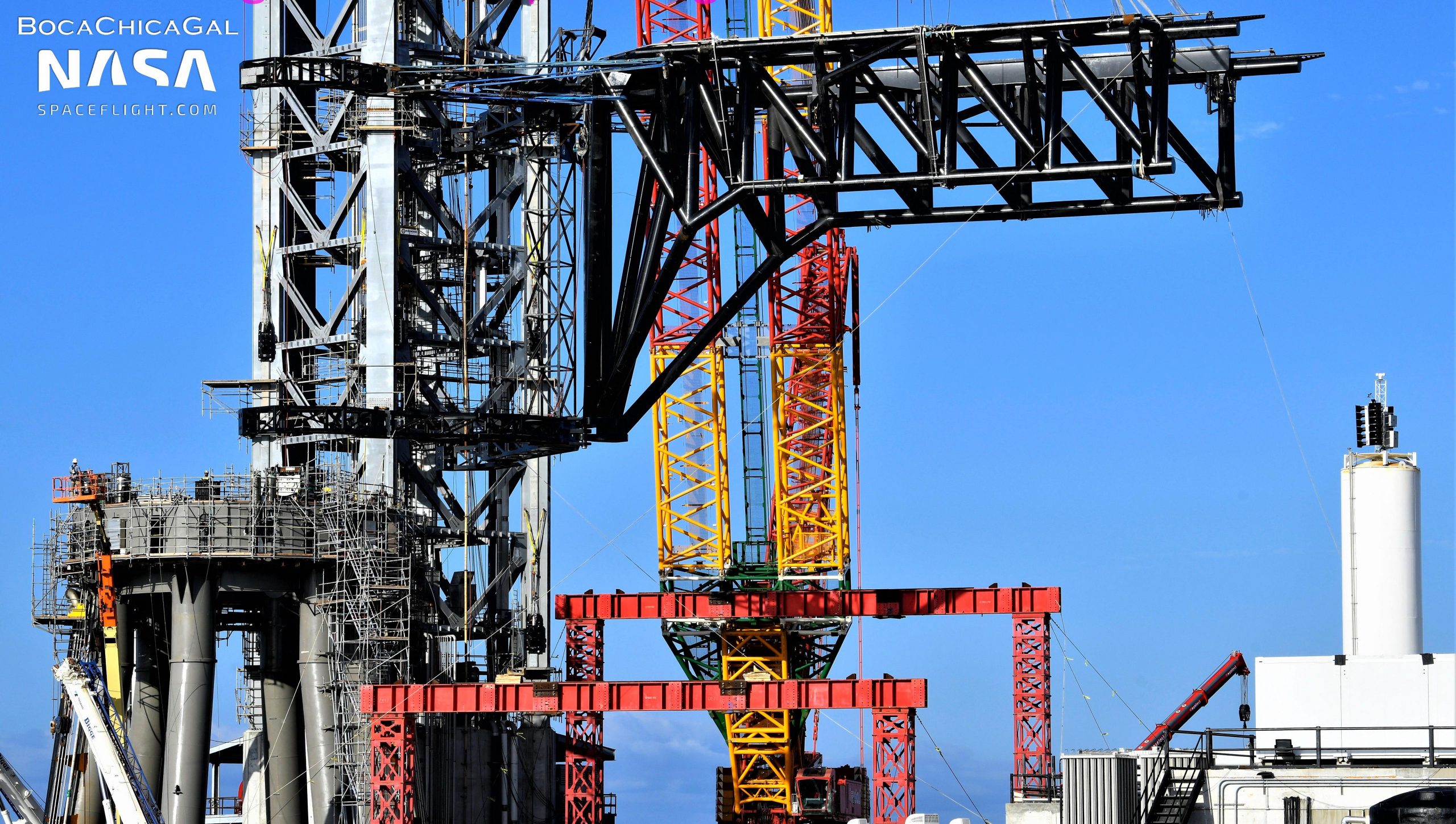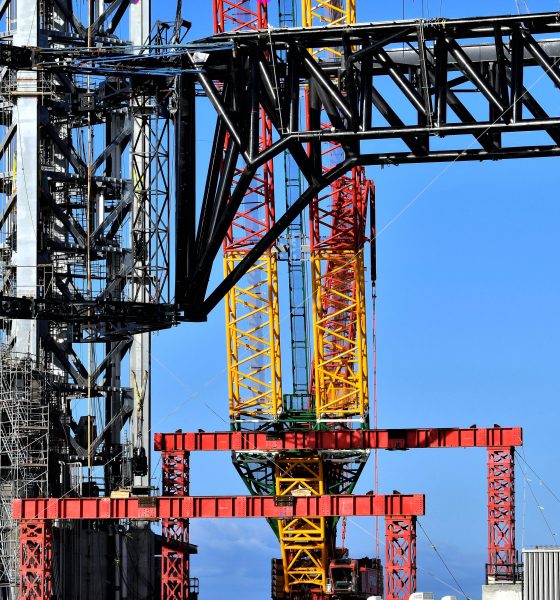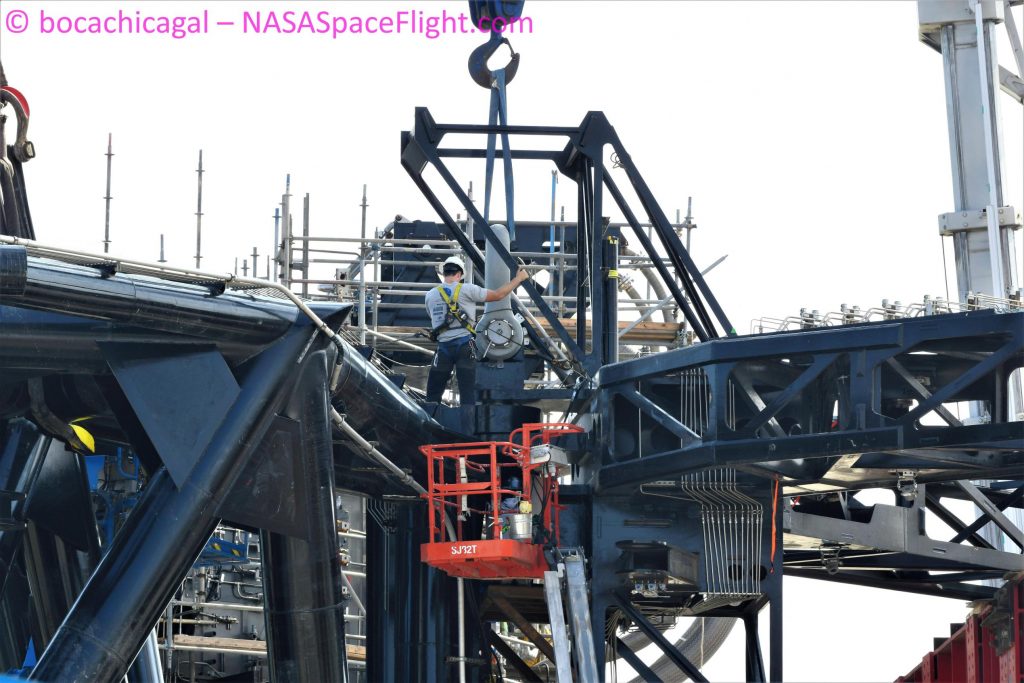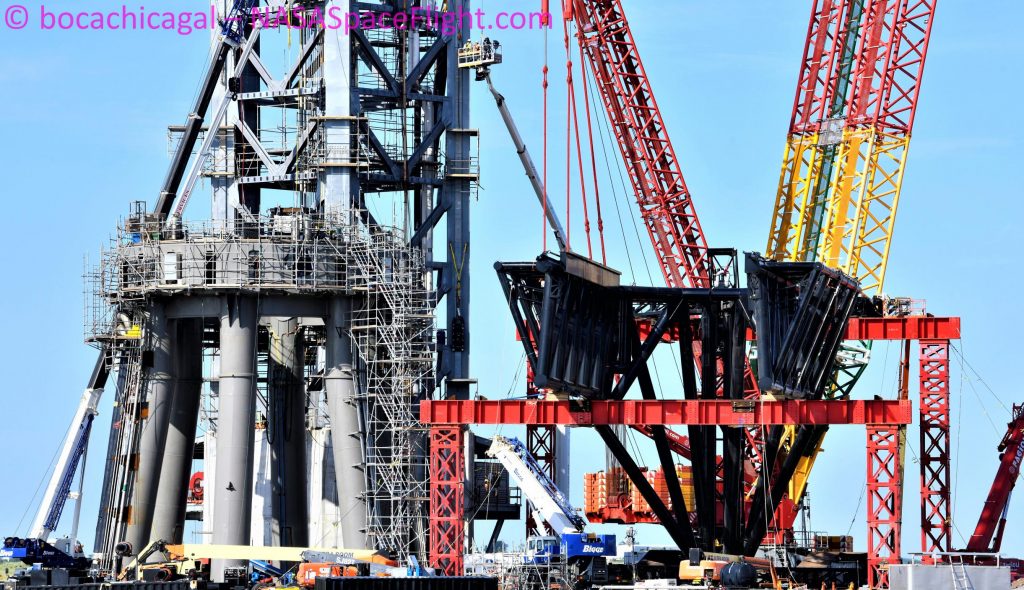

News
SpaceX begins installing ‘Mechazilla’ arms designed to catch Starship rockets
After a busy few weeks spent attaching Mechazilla’s two rocket-catching arms to a carriage-like backbone, SpaceX has begun the process of installing the integrated structure on Starbase’s ~450 ft (~135m) tall Starship ‘launch tower’.
Once complete, SpaceX will have created a first-of-its-kind launch tower designed to stack and manipulate Starships and Super Heavy boosters in far worse conditions than cranes can tolerate and catch both rocket stages out of mid-air. Referred to internally as ‘chopsticks,’ the giant pair of steel arms will join a third ‘quick disconnect’ (QD) arm tasked with stabilizing Super Heavy during Starship installation and feeding the reusable upper stage power, comms links, and some 1200 tons (~2.65M lb) of propellant.
Together, they will enable SpaceX to attempt Starship’s first orbital test flights and, perhaps one day, help the next-generation rocket launch in almost any weather and achieve unprecedentedly rapid reusability. But first, SpaceX needs to finish installing and rigging the massive structure.
Beginning on August 29th after less than three months of assembly, SpaceX installed Starship’s QD arm on the launch tower. About a month later, the QD arm was mostly finished off with the installation of a claw-like grabber meant to stabilize Super Heavy and is now only missing its namesake quick-disconnect (an actuating device that will connect Starship to the pad and rapidly disconnect at liftoff). Assembly of the last three major components of Mechazilla – a carriage-like structure and two giant arms – began in July and, much like the tower’s QD arm, wrapped up about three months later.
On October 6th, SpaceX began combining those three main parts by flipping the carriage – a bit like a spine and ribcage with ‘skates’ that attach to rails on the launch tower’s legs – vertical and staging it on a temporary support structure. Both ‘chopsticks’ were then flipped into the correct orientation and moved into position with separate cranes for installation on the carriage/backbone. From start to finish, that process took around 9-10 days and culminated with the installation of two giant cylindrical pins with built-in bearings on October 14th and 15th. By the 17th, both cranes had detached from the assembled Mechazilla arms and carriage were, leaving it precisely balanced against the support structure and more or less freestanding.


Just a few days later, after a last-second attempt on October 19th was called off as night fell, SpaceX tried again on the 20th and completed the first step of installing Mechazilla’s catch arms on the launch tower without apparent issue. Likely weighing several hundred tons, Starbase’s largest crane lifted the massive structure up and over an adjacent launch mount and then carefully inched it closer to the tower. Prior to the lift, SpaceX technicians staged 12 ‘skates’ on three of the tower’s four legs – two upper and two lower skates per leg.
Here's one with the QD arm back. If QD engaged, chopsticks can't get past. Elon said only need for "ship mate". Chopstick sequence:
1. Lift SH onto OLM
2. Rise, swing to side, lower, grasp SS
3. Rise above SH
4. Deploy QD arm and claw
5. Lower SS onto SH
6. At launch, open wide! pic.twitter.com/iRRfXQ5uEn— LunarCaveman (@LunarCaveman) October 1, 2021
Once the carriage was in the right position, workers were able to wrap its upper arms around the tower and began connecting the carriage to those skates with several more large pins. It’s unclear how much progress was made in the hours after the lift but it appears that the carriage has been attached to maybe four or five of six upper skates. Work continued well after nightfall, meaning that it will likely only take a few days to complete all 12 connections. However, even after all skates are installed, the carriage, arms, and skates will still be hanging by crane or winch.
To truly install the structure on the tower, SpaceX will have to finish installing and rigging thousands of feet of steel cable that – via a complex system of pulleys – will connect to powered ‘drawworks’ that will support the carriage and catch arms and lift the assembly up and down the tower like an elevator car. The catch arms and carriage will also need to be mated with a giant ‘cable carrier’ (already staged on the tower) that will connect the structure to ground and control systems.

Elon Musk
Elon Musk’s X will start using a Tesla-like software update strategy
The initiative seems designed to accelerate updates to the social media platform, while maintaining maximum transparency.

Elon Musk’s social media platform X will adopt a Tesla-esque approach to software updates for its algorithm.
The initiative seems designed to accelerate updates to the social media platform, while maintaining maximum transparency.
X’s updates to its updates
As per Musk in a post on X, the social media company will be making a new algorithm to determine what organic and advertising posts are recommended to users. These updates would then be repeated every four weeks.
“We will make the new 𝕏 algorithm, including all code used to determine what organic and advertising posts are recommended to users, open source in 7 days. This will be repeated every 4 weeks, with comprehensive developer notes, to help you understand what changed,” Musk wrote in his post.
The initiative somewhat mirrors Tesla’s over-the-air update model, where vehicle software is regularly refined and pushed to users with detailed release notes. This should allow users to better understand the details of X’s every update and foster a healthy feedback loop for the social media platform.
xAI and X
X, formerly Twitter, has been acquired by Elon Musk’s artificial intelligence startup, xAI last year. Since then, xAI has seen a rapid rise in valuation. Following the company’s the company’s upsized $20 billion Series E funding round, estimates now suggest that xAI is worth tens about $230 to $235 billion. That’s several times larger than Tesla when Elon Musk received his controversial 2018 CEO Performance Award.
As per xAI, the Series E funding round attracted a diverse group of investors, including Valor Equity Partners, Stepstone Group, Fidelity Management & Research Company, Qatar Investment Authority, MGX, and Baron Capital Group, among others. Strategic partners NVIDIA and Cisco Investments also continued support for building the world’s largest GPU clusters.
News
Tesla FSD Supervised wins MotorTrend’s Best Driver Assistance Award
The decision marks a notable reversal for the publication from prior years, with judges citing major real-world improvements that pushed Tesla’s latest FSD software ahead of every competing ADAS system.

Tesla’s Full Self-Driving (Supervised) system has been named the best driver-assistance technology on the market, earning top honors at the 2026 MotorTrend Best Tech Awards.
The decision marks a notable reversal for the publication from prior years, with judges citing major real-world improvements that pushed Tesla’s latest FSD software ahead of every competing ADAS system. And it wasn’t even close.
MotorTrend reverses course
MotorTrend awarded Tesla FSD (Supervised) its 2026 Best Tech Driver Assistance title after extensive testing of the latest v14 software. The publication acknowledged that it had previously criticized earlier versions of FSD for erratic behavior and near-miss incidents, ultimately favoring rivals such as GM’s Super Cruise in earlier evaluations.
According to MotorTrend, the newest iteration of FSD resolved many of those shortcomings. Testers said v14 showed far smoother behavior in complex urban scenarios, including unprotected left turns, traffic circles, emergency vehicles, and dense city streets. While the system still requires constant driver supervision, judges concluded that no other advanced driver-assistance system currently matches its breadth of capability.
Unlike rival systems that rely on combinations of cameras, radar, lidar, and mapped highways, Tesla’s FSD operates using a camera-only approach and is capable of driving on city streets, rural roads, and freeways. MotorTrend stated that pure utility, the ability to handle nearly all road types, ultimately separated FSD from competitors like Ford BlueCruise, GM Super Cruise, and BMW’s Highway Assistant.
High cost and high capability
MotorTrend also addressed FSD’s pricing, which remains significantly higher than rival systems. Tesla currently charges $8,000 for a one-time purchase or $99 per month for a subscription, compared with far lower upfront and subscription costs from other automakers. The publication noted that the premium is justified given FSD’s unmatched scope and continuous software evolution.
Safety remained a central focus of the evaluation. While testers reported collision-free operation over thousands of miles, they noted ongoing concerns around FSD’s configurable driving modes, including options that allow aggressive driving and speeds beyond posted limits. MotorTrend emphasized that, like all Level 2 systems, FSD still depends on a fully attentive human driver at all times.
Despite those caveats, the publication concluded that Tesla’s rapid software progress fundamentally reshaped the competitive landscape. For drivers seeking the most capable hands-on driver-assistance system available today, MotorTrend concluded Tesla FSD (Supervised) now stands alone at the top.
News
Elon Musk’s Grokipedia surges to 5.6M articles, almost 79% of English Wikipedia
The explosive growth marks a major milestone for the AI-powered online encyclopedia, which was launched by Elon Musk’s xAI just months ago.

Elon Musk’s Grokipedia has grown to an impressive 5,615,201 articles as of today, closing in on 79% of the English Wikipedia’s current total of 7,119,376 articles.
The explosive growth marks a major milestone for the AI-powered online encyclopedia, which was launched by Elon Musk’s xAI just months ago. Needless to say, it would only be a matter of time before Grokipedia exceeds English Wikipedia in sheer volume.
Grokipedia’s rapid growth
xAI’s vision for Grokipedia emphasizes neutrality, while Grok’s reasoning capabilities allow for fast drafting and fact-checking. When Elon Musk announced the initiative in late September 2025, he noted that Grokipedia would be an improvement to Wikipedia because it would be designed to avoid bias.
At the time, Musk noted that Grokipedia “is a necessary step towards the xAI goal of understanding the Universe.”
Grokipedia was launched in late October, and while xAI was careful to list it only as Version 0.1 at the time, the online encyclopedia immediately earned praise. Wikipedia co-founder Larry Sanger highlighted the project’s innovative approach, noting how it leverages AI to fill knowledge gaps and enable rapid updates. Netizens also observed how Grokipedia tends to present articles in a more objective manner compared to Wikipedia, which is edited by humans.
Elon Musk’s ambitious plans
With 5,615,201 total articles, Grokipedia has now grown to almost 79% of English Wikipedia’s article base. This is incredibly quick, though Grokipedia remains text-only for now. xAI, for its part, has now updated the online encyclopedia’s iteration to v0.2.
Elon Musk has shared bold ideas for Grokipedia, including sending a record of the entire knowledge base to space as part of xAI’s mission to preserve and expand human understanding. At some point, Musk stated that Grokipedia will be renamed to Encyclopedia Galactica, and it will be sent to the cosmos.
“When Grokipedia is good enough (long way to go), we will change the name to Encyclopedia Galactica. It will be an open source distillation of all knowledge, including audio, images and video. Join xAI to help build the sci-fi version of the Library of Alexandria!” Musk wrote, adding in a later post that “Copies will be etched in stone and sent to the Moon, Mars and beyond. This time, it will not be lost.”








